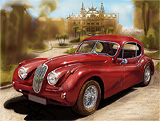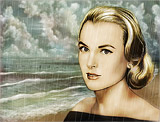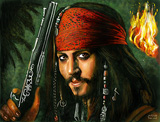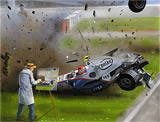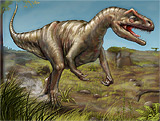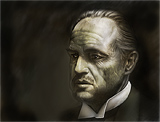Speed painting videos by Martin Missfeldt
A "Speed Painting" (also "Speedpainting", "fast painting") is a fast-painted picture. Martin Missfeldt has paintinted his first speed painting on 6th May 2007. Shortly before he had seen a speed painting by Nico di Mattia on youTube ( "LOST - John Locke").
At the same time, he had a request for a giraffe illustration after a poem of Russian poet Nikolej Gumiliev. Missfeldt decided to paint the requested cartoon digital on the PC. He installed a software to record the movements on the screen and began to paint with a tablet PC. After about 2 hours, he had not only finished the picture, but also about 400 GB of raw material from which he created a time lapse video. On 7th May 2007 was Missfeldts first speed Painting by Martin ready: The "Lonely Chad Giraffe".
Sorry for bad english: my coworker was a machine. Here the original german version: Speedpainting.
What is a speed painting video?
A "Speed painting" is a fast painted picture. While some people assume from the fact that it must be ready at maximum 30 min., Missfeldt thinks about a painting duration up to 3 hours. This article reflects about the development of digitally painted "Speed painting videos". These are videos which shows the process of the digital painting as a time-lapse video. Meanwhile there are numerous video-portals that shows these kind of videos. They can be looked there without long waiting periods as a stream. As examples Missfeldts user-sites on youTube and 5min.
The speed painting videos offer a new perspective on painting: In the foreground is not any longer the picture as an artefact, but the process of painting (more below).
Two types of speed painting
Basically there are two kinds of speed painting videos. The first ones concerns on "real" or traditionally pictures on canvas or paper. The painting process is taped with a digital camera. You can always see the hand which leads the pencil or paintbrush.
In the second method you can not see of the "real" surroundings. It concerns on digital pictures which are painted directly on the computer. In particular the operating hand (which also lies down always about parts of the picture) is absent. Nevertheless, instead, there are often different choice palettes (color picker, paintbrushes etc.) in the picture. The process of the digital painting is cofilmed by screenRecorder (computer software).
Ein How-to-do Speed painting Tutorial
To offer a general speed painting tutorial is pointless. There are dozens of methods to provide a speed painting video. In the centre stands logically the digital picture. Shortly a "Digital painting tutorial" is also offered on this website. Here the approach is introduced what Martin Missfeldt uses to provide speed painting videos out of digitally painted pictures.
Tools aund programms
First the following "tools" and programms or comparable products are important:
- a standerd computer (e.g., PC Intel duet Core2 3 mb, 2 GB RAM)
- enough hard disk space (e.g., 500 GB)
- graphic tablet (e.g., Wacom Intuos A4)
- a painting programme (e.g., Adobe photoshop)
- a screenRecorder programme (e.g., autoScreenRecorder free)
- an audio programm (e.g., audacity)
- a video making programme (e.g., Adobe afterEffects)
 Speed painting tutorial | working steps (from Capt. Jack Sparrow - working steps during digital painting)
Speed painting tutorial | working steps (from Capt. Jack Sparrow - working steps during digital painting)
Missfeldt has two Screens on his computer. On one he lays out reference material, e.g. wikipedia images. If he paints after reference pictures, he looks occasionally at the picture. On the main screen Adobe photoshop CS3 is opened with which he paints the picture. Of course it is also possible to work only with one screen. The picture format amounts with most of his pictures in 2380 x 1810 pixels with 72 dpi resolution. This double screen-size on a 19 inches screen. Therefore, with a view size of 50 percent the picture is to be seen full. The advantage is that you can zoom in with good quality. This problem is solved in photoshop CS4.
He paints the pictures in "stages" of approx. 10 - 20 min duration. This has quite practical reasons: on the one hand, the video-size which are codrawn from screenRecorder should not become too big. The raw material has in this period approx. 150 - 250 mb data size on disc. Not bad to save sometimes. Second the interruptions always offer a good opportunity to think once more about the picture, the state and the other approach - and to drink in complete silence a cup of coffee ...
Tutorial working steps : "Drawing shadow - drawing light - gaussian blur"
Missfeldt plays with different methods of digital painting. Several times he uses the method "Drawing shadow - drawing light - gaussian blur". The working process is really simple and always the same (see pictures on top and below: "working steps"):
- working step 1: First drawing sketch
- working step 2: New Layer: Backgroud color
- working step 3: New Layer - drawing shadows and bluring layer
- working step 4: New Layer - drawing lights and bluring layer
- working step 5: New Layer - half-transparent colors, to avoid "greying"
- working step 6: Repeat step 3 to 5. reduce the strength of blur
- working step 7: Final details drawing (hair, light in the eyes etc.)
 Speed painting tutorial - picture details (working steps of the paint process: -"Drawing shadow - drawing light - gaussian blur")
Speed painting tutorial - picture details (working steps of the paint process: -"Drawing shadow - drawing light - gaussian blur")
After approx. three hours the photoshop picture is ready. The painting process is documented in about 20 raw material videos. Afterwards there comes the difficult job to find the right music which supports the video, the painting process and the final picture appropriately. For a painter not easy. Then with this material a time-lapse photography video is provided with Adobe afterEffects (or another video cut programme) and redner out as Quicktime movie.
Finaly the finished movie is compressed with the Flash-Video-Encoder in a Flash-video (.flv). It has only approx. 10% of his original file size. Now it is suitable to the upload on the current main video-portals.
Digital painting - advantages and disadvantages
The digital painting offers two determining beneficials in comparison to the traditional painting: On the one hand, you can save single working steps and if necessary return to older versions. On the other hand you can work in different picture layers which can be reworked separately. For an effective thinking painter a real advantage.
Determining disadvantage of a speed painting is of course the loss of the "original picture" in a traditional sense. There is no "real thing" more to grab or get. You cannot look at it from near and from a distance. The only way out is a print-out which knows, however, no structure, no haptics, just no individual working tracks.
Nevertheless, a real advantage and added value is the possibility to tape the digital painting process as a speed painting video. Thus originates, depending on the Screen resolution, a high-resolution video. In the post-production with Adobe AfterEffects (or a comparable video-treatment programme) this raw material can be compressed and finished playing as a time-lapse video. Thus becomes from a painting process of approx. 3-hour duration a speed painting of approx. 4 minutes playing length.
What is important with speed paintings?
The interesting thing in speed painting videos is absolutely that they fucus on the painting process. The final picture becomes less important. This turns the traditional production of artistic work headover. Up to now the final result - the picture - stands in the centre of artistic production. Now, however, the process stands in centre - the final picture is rather a "waste product". It has originated just only by the way during the painting process. From this point of view is not any more the picture than artistic product. It is rather the video which must be called artistic. As traditional pictures a speed painting can only be under "art suspicion" when it becomes public. The video-portals offer far higher chances of winning publicity than in a traditional art context.
History of the speed painting videos
The following representation of the "historical development" of the speed painting videos are based on searches by Missfeldt. They are on no account protected and are entire with certainty not roughly. In the following list Milestones of thenew "genre" speed painting on youTube are listed chronologically.
Speed painting Milestones
- 27. Aug. 2006 -> Sycra (?, Canada) publishes a Video-Tutorial which shows the drawing of a head (up to now approx. 4,600 clicks)
- 13. Sept. 2006 -> macpulenta (Nico di Mattia, Argentina) publishes on youTube a traditionally painted picture after a "Lord of the rings" poster (up to now approx. 230,000)
- 04. Okt. 2006 -> Madinker (Michael?, the USA) a car with ms Paint (up to now approx. 1.5 million) paints
- 20. Nov. 2006-> picster (Raffaele Picca, Germany) answers it, also by a car (up to now approx. 5.1 million)
- 09. Febr. 2007 -> macpulenta paints "Thom of York" (up to now approx. 1.2 million), for the first time photoshop is used
- 24. Feb. 2007 -> macpulenta paints "John Locke" from the TV series "LOST" (up to now approx. 6.2 million)
- 08. März 2007 -> arbaon (Bill Corbett) paints "Kate Beckinsale" from "LOST" (up to now approx. 18,000) and uses for the first time the title "Speed painting" (in the video, the titles of the videos are not trustfull, because they could have been changed later)
- 09. März 2007 -> origiful (Ian Padgham, the USA) "One paints Ray Speed Paint" (up to now approx. 245,000)
- 14. März 2007 -> arbaon paints "Kate Austen" from "LOST" (up to now approx. 290,000)
- 25. März 2007 -> mohacsizsolt (Mohacsi Zsolt, Hungary) paints "Jigsaw" (up to now approx. 770,000)
- 29. März 2007 -> EclecticAsylumArt(Jason Baalman, the USA) answers to Picstars "car" with "Mona Lisa", painted with MS paint (up to now approx. 8.5 million)
- 30. März 2007 -> MathiasVerhasselt (USA) paints a surreal Science fiction paints scenery in 20 min. ("speed painting") (up to now approx. 76,000)
- 02. April 2007 -> Philinthecircle provides "Bruce Lee" as a real "Karate" happening and films the origin process (up to now approx. 2.5 million)
- 10. April 2007 -> Mimmo (Manlio Noto, Italy) "Spiderman" paints (up to now ca.1.6 million)
- 02. Mai 2007 -> macpulenta awnsers with his "Spiderman" (up to now approx. 6.7 million)
- 24. Mai 2007 -> norwegyan(Josiel Souza, Brazil) paints "Jessica Alba" (up to now approx. 140,000)
- 17. Aug. 2007 -> mssfldt (Martin Missfeldt, Germany) paints "Albert Einstein" (up to now approx. 170,000)
- 23. Aug. 2007 -> dscru (Steven?, Great Britain) paints "Beyonce" (up to now approx. 430,000)
- 03. Okt. 2007 -> cgsbgs (Chris Scalf, the USA) paints a "dragon" (up to now approx. 420,000 clicks)
* State: 09. Sept. In 2008 - There are hundreds of other artists: www.youtube.com/results?search_query=speed+painting
The "most successful" speed paintings and their motives
In the following the speed paintings which can be seen on youTube are analysed. The main criterion for "success" is the click rate of the videos, so basically the popularity of the videos. Just this perception is interesting and to question. Can the quality of a video - and with it the quality of a finished picture - can the quality be seen in the click rates?
However, there are at the moment no more expressive appoximate values: measured in the click figures interesting manner the videos in which especially trivial, non-saying motives have held out as authoritative pictures is liked. Spiderman, Batman, Ironman etc.: the list of the film stars in Speed paintings is long. But also cars or Mona Lisa are extremely popular. The supposition is obvious that the respect is more adequate with Speed painting videos, the more one has the "model" in the head. A viewer can possibly identify with the painting process if he already knows the final picture. "Yes, exactly, properly! Thus it is!" accompanies the perception. By contrast developed, artistic pictures on youTube are ignored independently pitilessly.
Missfeldt's picture-themes
Since Missfeldt had publicised the "Lonely Chad giraffe" speed painting video on youTube, he deals with the questions which arise from the abovementioned considerations. His motives arise from his biographical context - however, in the context of the youTube speed painting videos he also experiments with "foreign" motives.
Weblinks
- www.wikipedia.org/wiki/Speed painting - (not very well) article on Wikipedia
- nicodimattia.wordpress.com (Blog by speed painter Nico di Mattia)
Galleries with speed painting videos by Martin Missfeldt:
- Speed painting - speed art videos
- Icons of culture - speed painting art videos
- Icons of movie history - time lapsed painting videos
- Great composers - speed painting art videos
- Speed-painting - concept art
